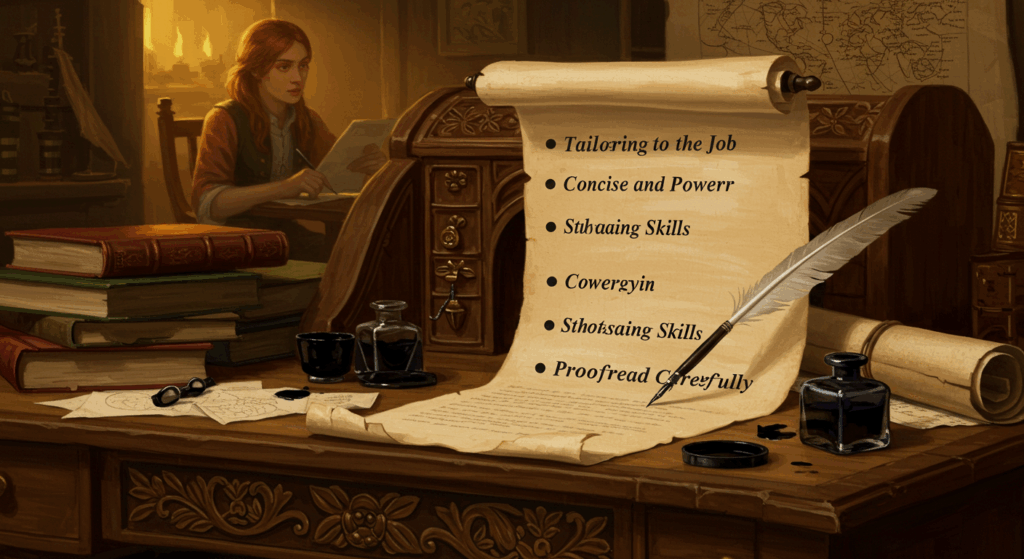If you’re staring at a blank Google Doc whispering “dear hiring manager” like it’s a summoning spell… same. Writing a cover letter can feel weirdly high-stakes and also low-energy at the exact same time (like choosing a Netflix show when you’re already sleepy). But here’s the real talk: with a few best practices—and a little personality—you can write a cover letter that doesn’t just exist. It lands.
This guide is the friend-in-your-laptop version: conversational, slightly messy in a human way (ngl, a typo or two might sneak in), and focused on what recruiters are actually scanning for in those 15 seconds before Slack pings them back to chaos. We’ll hit the big buckets—formatting, content, and real-world examples—and show you how to structure a letter that feels like you, while still checking the boxes hiring teams expect.
Grab water. Crack your knuckles. Let’s make the blank page less scary.
Why Cover Letters Still Matter (Even When the Job Post Says “Optional”)
A cover letter is the quick bridge between your résumé and the human reading it. It explains:
- why this role,
- why you, and
- why now.
It’s also the easiest place to show vibe, context, and communication skills—things that bullet points can’t fully capture. Think of it like a short voice memo to the hiring team that says, “Here’s how I’d solve your problems and fit your culture, in 300–500 words.”
And yes, even if the application says “optional,” a sharp letter is a differentiator. When hundreds of resumes come in with no explanation, yours—customized with specifics—feels like a warm handshake. (A clean one. Not the weird clammy shake. You’re good.)
The Core Idea: Make It Easy to Skim, Impossible to Ignore
The best cover letters do three things:
- Signal alignment in the first 2–3 sentences (keywords + what the team cares about).
- Prove impact with one or two concrete, numbers-backed wins.
- Close with momentum—a confident, polite call to action that sets up the next step.
Everything else? Trim the fluff. This is not your memoir (yet).
Formatting That Helps You Get Read (Not Just “Look Professional”)
Your formatting doesn’t need to be fancy—just clean and consistent with your résumé. Keep it simple, scannable, and ATS-friendly.
Your Header
- Mirror your résumé header (name, phone, email, LinkedIn/portfolio).
- Add the date and the company’s name + location (or “Remote”).
- If you’ve got a contact person, include their name and title. If not, skip the guesswork.
Font + Layout
- Use a readable font (11–12 pt). No script fonts. This is not a wedding invite.
- One page max. 300–500 words is the sweet spot.
- 1.0–1.15 line spacing; extra space between paragraphs.
- Left-align everything; no two-column layouts that break on mobile or in HRIS systems.
File + Naming
- Export as PDF unless the portal demands a doc.
- File name:
First-Last-Cover-Letter-Company-Role.pdf. It’s free polish.
Tiny Visual Tweaks That Help
- Bold the role title or company name in your first paragraph. It pops during a skim.
- If you use bullets, limit to 2–3. Keep them tight, each with a result.
If you remember one sentence about formatting: the goal is “looks neat in two seconds,” not “design award.”
Content That Does the Heavy Lifting
You don’t need a complicated script. Nail these five parts and you’re golden:
- A targeted opener
Signal you understand the role, the team’s goals, and why this company. Two to three sentences, tops. - The “value promise” line
One sentence that connects your strengths to the hiring manager’s priorities. Ex: “I help B2B teams turn product launches into pipeline with smart lifecycle content and clean analytics.” - Two proof points (mini stories)
Short, numbers-backed wins. Translate past success into future value for their context. - Culture/fit signal
Hint you’re aligned with how they work: scrappy, regulated, hypothesis-driven, customer-obsessed, whatever. - A confident close
Thank them, restate your value, ask for the next step.
Keep content focused on outcomes (“what changed because of me?”), not responsibilities (“what I was supposed to do”). Outcomes sell.
A 10-Minute Research Sprint (So Your Letter Isn’t Generic)
You don’t need to stalk the entire internet. Skim fast:
- Job description: underline 3–5 core priorities in your own words.
- Company site or blog: look for recent launches, customer segments, or growth signals.
- LinkedIn page or press: any market shifts or new geographies?
- Glassdoor (lightly): tone and values clues, not gospel truth.
Grab two phrases from the JD and one phrase from the company language to echo in your letter. That’s enough to sound like you did your homework without losing your voice.
The First Lines: Hooks That Don’t Make People Cringe
Bad: “I’m writing to express my sincere interest…”
Better: “I’m excited about the Marketing Coordinator role at Aster Labs because you’re expanding into SMB—exactly where I’ve grown pipeline with scrappy, data-first campaigns.”
Other opening options:
- Momentum hook: “You just launched [Feature X] for creators. That’s my whole thing—shipping user-loved features with clean onboarding and fewer support tickets.”
- Customer empathy hook: “I’ve supported 200+ customers through messy migrations, so I know how to keep NPS high when the roadmap gets spicy.”
- Mission hook: “I care about access in fintech. My last role focused on lowering approval bias and simplifying UI for first-time borrowers.”
Keep it specific. Three sentences max. Then move.
Body Paragraphs: Three Simple Frameworks (with content “formulas”)
Pick one of these frameworks for your content flow. All three work; choose the one that suits your story.
1) The “Problem → Action → Result → Relevance” (PARR)
- Problem: “Our churn spiked at renewal.”
- Action: “I rebuilt the nurture journey with usage-based triggers.”
- Result: “Renewals rose 11% in two quarters.”
- Relevance: “Your role mentions lifecycle and retention; I’ve done both.”
2) The “Two Bullets + One Bridge”
- Bullet 1: “Drove 40% demo lift by tightening paid search to high-intent themes.”
- Bullet 2: “Cut CAC by 18% with creative refresh + landing page speed fix.”
- Bridge: “Your current push into B2B self-serve needs this exact combo: intent + speed.”
3) The “Mini Case Study”
Two to four sentences, one story, one metric:
“Last quarter I owned onboarding for our mid-market plan. I ran JTBD interviews, killed a confusing step, and moved help content in-app. Activation rose from 27% → 43% in 8 weeks. I’d bring the same ‘measure + simplify’ approach to your new tiered pricing rollout.”
Put one or two of these in the center of the letter. Done.
Closings That Don’t Sound Like a Robot
Skip “I look forward to hearing from you” (yawn). Try one of these:
- “I’d love to share how I can help you hit the Q4 acquisition targets—especially the organic lift you called out.”
- “If helpful, I can walk through the analytics dashboard I built to track activation and churn drivers.”
- “Thanks for reading. If the team values ownership, speed, and a little nerdy dashboard joy—I think we’ll get along great.”
Add a P.S. if you have a quick bonus: “P.S. I shipped a 2-minute loom demo of how I’d optimize your signup flow—happy to share in an interview.”
Tone: Professional but Human (Use Your Normal Voice)
- Match the company’s energy. If their brand voice is playful, nudge playful. If it’s clinical/regulated, keep your language crisp.
- Use “you” more than “I.” Focus on employer outcomes.
- Sprinkle personality—lightly. A tiny joke lands; a stand-up routine does not.
- Little imperfections make you sound real. Not a ton, just a couple. (Like this: hmm, definitley don’t over-think it.)
Addressing Gaps or Swerves (Career Switchers, Students, Returners)
If you’re switching careers
Highlight transferable skills + a recent proof:
“After 3 years in teaching, I’m moving to Customer Success. The overlap is real: complex stakeholder communication, patient troubleshooting, and measurable outcomes. I’ve completed the SuccessHacker course and managed a 15-account volunteer CRM migration where we cut ticket backlog by 31%.”
If you’re a student/new grad
Lead with projects, internships, measurable wins:
“As Product Lead for our capstone, I ran 14 user interviews, prioritized the backlog, and shipped a working MVP that won ‘Best UX’. I’d bring the same bias for shipping to your Associate PM role.”
If you have a gap
Own it, then pivot to value:
“I took 9 months to care for family. During that time I finished the Meta Ads cert and built a $600/mo micro-store (ROAS ~3.1x). I’m ready to bring fresh energy to your paid social push.”
If you’re returning after layoffs
Normalize it + prove momentum:
“I was part of the April RIF at PeakData. Since then, I’ve been contracting: rebuilt a pipeline dashboard for a seed-stage SaaS and got their SDR demo rate from 3% → 6%.”
Keywords Without Being Cringe (Yes, ATS is Still a Thing)
ATS systems skim for alignment. Don’t stuff; mirror:
- Grab 3–5 exact phrases from the JD (e.g., “lifecycle campaigns,” “SQL,” “patient onboarding,” “Figma prototypes,” “HIPAA compliance”).
- Sprinkle them naturally in your content, ideally in your opener and proof points.
- Use the same role title they posted. “Customer Success Manager” vs “Client Success.”
Your goal: sound like a human who read the post, not a bot that ate it.
Common Mistakes to Avoid (Huge Time-Savers)
- Reusing the same letter for 20 jobs. It shows.
- Leading with what you want (“I’m seeking growth…”). Start with what they need.
- Including everything you’ve ever done. One or two wins, not a career documentary.
- Passive phrases like “responsible for.” Switch to action + result.
- Weird salutations. If you don’t have a name, just start with a strong hook; “Hello” or “Hi team” is fine in modern orgs.
- Bloated formatting. Headers, images, tables—just… no. Keep it light.
Examples You Can Steal (Please do)
Below are short examples you can adapt. Keep your facts, swap the context.
Example #1 — Marketing Coordinator (SaaS)
Opener
I’m excited about the Marketing Coordinator role at BrightLoop—especially your push into self-serve. That’s where I’ve helped two teams translate scrappy content into actual pipeline (not just vibes).
Body
- At CloudArc, I tightened paid search to high-intent themes and matched landing page copy to queries. Demos up 38% in a quarter; CAC down 17%.
- I rebuilt lifecycle emails around usage events (think: “aha-moment within 48 hours”). Activation rose from 22% → 36% in 8 weeks.
I like that your JD emphasizes experimentation and clean analytics. My dashboards tracked funnel steps, not just clicks, so we could kill under-performers fast.
Close
I’d love to help you hit Q4 sign-up targets and make the self-serve experience feel, you know, actually self-serve. Thanks for reading—I’m around next week to chat.
Example #2 — Product Designer (Consumer App)
Opener
You just launched a creator feature and teased a new onboarding. That’s my jam. I’m applying for the Product Designer role at Echo, drawn to your “make creativity effortless” mission.
Body
I’ve shipped three onboarding revamps in the last year. My playbook: user interviews → slice steps → progressive disclosure. In our last release, time-to-first-post dropped from 3m40s to 1m55s, and support tickets about account setup fell 42%. I design in Figma, partner tight with PM/Eng, and prototype with real data so we test scenarios early (dark mode + edge cases included).
Close
Happy to walk through a 5-minute loom on my “less choices, more momentum” flows. If your roadmap is speeding up, I think we’ll click.
Example #3 — Customer Success Manager (B2B)
Opener
I’m applying for Customer Success Manager at Northbeam because you’re scaling mid-market—and that’s where I’ve kept renewals high even when product was, uh, a little spicy.
Body
I owned 38 accounts ($4.2M ARR), ran QBRs with clean health scores, and built “fast fix” guides with Support that cut average time-to-resolution by 29%. When we launched a tricky analytics update, I piloted a hand-held onboarding cohort—churn risked accounts stabilized, and expansion in the group hit +11% over baseline.
Close
If you value calm communication, fast triage, and actual partnership, I’d love to support your customers through the next release cycle.
A Full Letter (Formatting + Content Together)
Use this as a template. Swap details, keep the bones.
[Your Name]
[Phone] • [Email] • [LinkedIn/Portfolio]
[Date]
Hiring Manager
Company — Remote
Hi team,
I’m applying for the Lifecycle Marketing Specialist role at Crescent. You’re expanding your self-serve plan and leaning into activation—exactly where I’ve helped scrappy SaaS teams turn signups into sticky users.
At NeoStack, I rebuilt our onboarding to trigger messages off actual usage (not just time). We moved the “aha” moment earlier by surfacing templates in-app and pinning a two-step quickstart. Activation rose from 24% → 39% in two months, and support tickets about “how do I start?” dropped 35%. I also tightened paid search to intent-heavy queries and matched ad copy to the landing page; demo volume grew 41% while CAC fell 16%.
I’m drawn to Crescent’s focus on experimentation and learning loops. My dashboards don’t just count clicks—they map funnel steps so we can stop what’s not working and pour gas on what is. I write fast, I’m not precious about iterating, and yes, I’m the kind of person who fixes broken UTMs at 11 pm because it’s bugging me.
I’d love to share how I’d structure a 30-60-90 for your activation goals, including quick wins in week one. Thanks for your time—and if you want a nerdy peek, I can walk through my cohort analysis in 5 minutes flat.
Best,
[Your Name]
(Note the clean formatting, outcome-first content, and how the examples aren’t generic. That’s the move.)
Role-Specific Lines You Can Copy-Paste
Sometimes you just need a sentence that “sounds right.” Borrow these, then tweak.
- Engineering: “I reduce cycle time by automating flaky tests and documenting decisions, so shipping stays fast without breaking Friday.”
- Data: “I turn messy product data into decisions by building clear Looker dashbords and adding the business context teams actually use.”
- Ops: “I map processes, remove steps, and add meaning—so the team spends less time chasing info and more time delivering work.”
- Sales: “I connect discovery to value, write tight follow-ups, and keep my pipeline honest so forecasts don’t become fiction.”
- Design: “I balance craft with speed—test early, cut cleverness that confuses, and document patterns so the product feels like one product.”
Quick Formatting Checklist (Print-Brain Friendly)
- Header matches résumé with links that actually work
- Role title matches job post exactly
- 300–500 words, single page, PDF export
- Clean formatting: 11–12 pt font, left-aligned, 1–1.15 spacing
- Compelling opener that names the company + role
- One or two quantified wins (clear metrics)
- One culture/fit sentence
- Confident close with a suggested next step
- Optional P.S. (portfolio or loom demo)
- File name clean; email subject: “Application — [Role], [Your Name]”
FAQ-ish Speed Round
Do I need to address it to a person?
Nice if you have it; not a dealbreaker. “Hi team,” is fine in modern orgs.
How long should it be?
Aim for 300–500 words. Enough space to prove impact; short enough to finish before a Slack ping.
Bullets or paragraphs?
Either is fine. If you use bullets, 2–3 max with crisp outcomes.
What if I don’t have direct experience?
Lead with transferable proof (projects, volunteer work, relevant coursework). Show fast learning + adjacent wins.
Can I reuse a template?
Yes, but rewrite the opener, swap in role-specific metrics, and echo 2–3 phrases from the JD.
Do I mention salary or availability?
Not in the letter. Save comp convo for later; availability can wait until the interview unless they asked.
Advanced Move: The Micro-Project (Optional but Spicy)
If you really want to stand out, include a tiny deliverable:
- For marketing: a one-paragraph channel plan or a sample subject line test.
- For product: a 3-bullet usability critique + a low-fi sketch.
- For data: a screenshot of a prototype dashboard with the 3 metrics that matter.
- For success: a short email template that turns a renewal risk into a save.
Drop it as a link or mention it in a P.S. Don’t overbuild (no 20-page decks). Keep it snackable.
Putting It All Together (formatting + content + examples in one flow)
- Start with a hook that shows why you’re excited about their goals.
- Mirror a couple JD keywords (lifecycle, retention, compliance, whatever) in natural sentences.
- Offer two wins with metrics that match those priorities.
- Signal culture fit in one line (fast, regulated, research-heavy, cross-functional).
- Close with a next step (“happy to share X,” “can walk through Y”).
- Keep the formatting clean, and your content tightly focused on impact.
- If you’ve got examples (portfolio, code, campaign), link them—no treasure hunt.
That’s it. Seriously.
A Few “Before & After” Mini-Examples
Before: “I was responsible for email marketing.”
After: “I rebuilt onboarding emails around usage events; activation rose from 22% → 36% in two months.”
Before: “Led cross-functional teams.”
After: “Partnered with Eng/Design to cut omboarding steps from 7 to 4, reducing support tickets by 42%.”
Before: “Improved website.”
After: “Simplified the pricing page and cut load time by 1.3s; trial signups increased 19%.”
Each “after” is specific, metric-backed, and portable to a new company’s goals.
Final Touches That Quietly Level You Up
- Read it aloud. You’ll catch awkward phrasing and run-ons immediately.
- Ask: “So what?” after every sentence. If it doesn’t move your value forward, cut it.
- Check links. Nothing kills momentum like a 404.
- Save a clean template. Then customize the top 50% each time.
- Send it the day you’re excited. Energy shows, weirdly. (Also: refresh your LinkedIn headline to match the role title—tiny SEO boost.)
Your Turn (You’ve Got This)
You don’t need to be Shakespeare. You don’t even need to be “ready.” But you need formatting that’s clean, content that proves you move needles, and examples that make a hiring manager think, “Yep, bring them in.”
Open a doc. Draft the opener. Drop two wins. Add a confident close. Then ship it.
You’re closer than you think. Hit send—future-you is gonna be proud.









